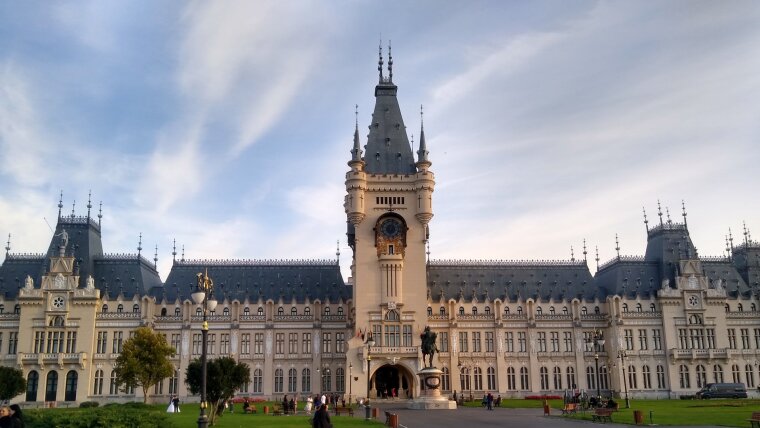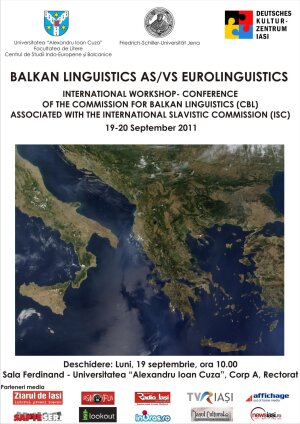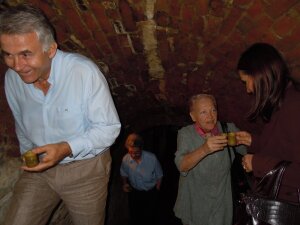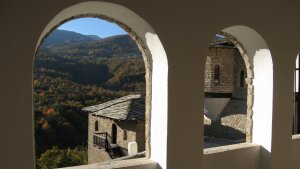
Adrian Poruciuc guiding through the catacombs of Bolta rece.
Foto: Ofelia IchimJust one year after the conference of the International Commission for Balkan Linguistics in Vienna in September 2010, thanks to the initiative of Romanian linguist Adrian Poruciuc, it was possible to hold another conference of the Commission in Iași, Romania. The conference was organised by the Faculty of Letters and the Centre for Indo-European and Balkan Studies at Alexandru Ioan Cuza University in Iași, in cooperation with Friedrich Schiller University Jena, represented by Thede Kahl, and the German Cultural Centre in Iași.
Poster of the conference in Iași 2011
Illustration: Commission for Balkan LinguisticsWhile ‘Balkanisms’ were the central topic in Vienna, the focus in Iași was on further describing the similarities and differences between Balkan linguistics and the new linguistic discipline of ‘Eurolinguistics’. The concept of the language union and the associated Balkanisms as a term for the similarities between the Balkan languages had long been questioned, and at the end of the 20th century, attention was drawn to the obvious similarities between the Balkan languages and other European languages [1]. The Commission for Balkan Linguistics at the International Slavic Committee was established in 1993 on the occasion of the 11th International Slavic Congress in Bratislava and has since held a number of academic conferences, the first of which took place in Marburg in 1997 and dealt with current issues in Balkan linguistics. In 1999, the German Research Foundation's research project ‘Kleiner Balkansprachatlas’ (Small Balkan Language Atlas) was also established there [2], then in 2002 in St. Petersburg with a similar topic and the question of creating a Balkan language atlas, in 2002 in Sofia with the topic of similarities in the vocabulary of Balkan languages, in 2004 again in St. Petersburg with the topic of small ethnic groups on the Balkan Peninsula, in 2006 in Belgrade with the topic of Romance elements on the Balkan Peninsula, in 2008 in Berlin with the topic ‘Innovations in contact linguistics on the Balkan Peninsula – trends and perspectives’, and in 2009 in Veliko Tarnovo, where the central topic was the verbal system of Balkan languages – heritage and innovation. In Vienna in 2010, the theme of the conference was ‘Balkanisms today’.[3]
Romania not only has numerous connections to other South-Eastern European countries, but has also made significant contributions since the 19th century to the scientific study not only of Romanian, but also of all Balkan languages. Suffice it to mention the well-known names of Alexander Philippide, Sextil Pușcariu, Alexander Rosetti, Alexander Graur and Iorgu Iordan. Austria and Germany can also look back on a rich tradition in the field of Romanian and Balkan studies, with names such as Franz Miklosich in Vienna, Friedrich Diez in Bonn, Gustav Weigand in Leipzig, Ernst Gamillscheg and Günter Reichenkron in Berlin. Founded in 1860, Ioan Cuza University in Iași is the oldest Romanian university and today has not only a Romanian and Slavic Studies Department and a Centre for Indo-European and Balkan Studies. In 1999, the University of Iași Press also published an introduction to Balkan linguistics in Romanian by Klaus Steinke and Ariton Vraciu [4].
Dhori Qirjazi discovering the exit from the Bolta rece catacombs
Foto: Ofelia IchimThe following topics were scheduled for discussion: genealogical, typological and areal language analysis, contributions of Balkan linguistics to the further development of Eurolinguistics, possible contributions of Balkan linguistics to the development of Slavic linguistics, home language vs. lingua franca in Southeast Europe, language islands in Southeast Europe, sources of neologisms in Southeast Europe, and interdisciplinary approaches to ‘Europeanity’.
The conference in Iași was held as an international workshop and, after a welcome address by Adrian Poruciuc, opened with a presentation of the conference's objectives and expectations, followed by a lecture by Helmut W. Schaller on the interrelationship between the ‘Balkan language union’ and the ‘Baltic-Slavic language community’, combined with the question of whether these are common linguistic features of a European language community. If the ‘language union’ represents a group of languages that are linked by typological features, the well-known “Balkanisms”, then the ‘language community’ forms a genetic-based correspondence between at least two languages, such as the predicative instrumental and the genitive with negative objects in Slavic languages and in Lithuanian. Thede Kahl/Vienna-Jena opened up a whole new aspect of Balkan linguistics with his presentation of the development of grammatical terminology, starting with the first descriptions of Balkan languages and continuing to the current normative grammars and the grammatical terminology commonly used there. Klaus Steinke/Erlangen-Krakow discussed the position of Romanian and Romania in relation to the Balkan language union. He recalled the somewhat sceptical attitude towards the Balkan language union, since Romania belongs to Southeast Europe but not necessarily to the Balkan Peninsula. Sextil Pușcariu had already taken a distanced stance on the concept of the Balkan language union in his description of the Romanian language, published in German in 1943, which had been developed between the two world wars by the Prague School under the leadership of Nikolaj Trubetzkoy, Roman Jakobson and Bohuslav Havránek.
The section ‘Words and Identities’ was chaired by Victor Friedman, where Todor Todorov/Sofia spoke about the etymology of two borrowed Balkan words in Bulgarian, namely “terjasvam” and ‘terk’, followed by Corinna Leschber/Berlin with criteria for analysing Slavisms in Romanian. It is well known that Slavic elements make up a considerable proportion of Romanian; the question addressed here revolved primarily around whether certain dialect areas of Daco-Romanian were particularly strongly affected by Slavisms, and whether these were Slavisms of Bulgarian, Serbian or even Ukrainian origin. Krasimira Koleva/Shumen dealt with linguistic facts that are important for the linguistic identity of the Goran enclave in southern Kosovo. Doris Kyriazis/Thessaloniki dealt with Slavic elements in Greek idioms of southern Albania, referring in detail to earlier research by Meyer (1891 and 1894), Seliščev (1931), Vasmer (1941) and others. Adrian Poruciuc/Iași discussed old Germanisms on the Balkan Peninsula and in other parts of Europe. Old Germanic elements were adopted into the Balkan languages and the rest of Europe over long periods of time, from the 2nd to the 7th century AD, from Spain to Russia, from Finland to Italy, and Germanic elements can also be found in the South Slavic languages, as well as in Romanian, Albanian and Greek. Victor Friedman spanned the arc from Europe and Eurasia to Southeast Asia and raised the question of areal linguistics for the 21st century. He pointed out that beyond Europe, not only in the sense of Trubetzkoy and Jakobson, can one speak of a Eurasian language union, but also that the languages of the Caucasus, South and Southeast Asia show a remarkable number of typological similarities, which make the conception of further language unions seem possible. Jürgen Kristophson discussed rare vernacular words in early Modern Greek, Irena Sawicka/Toruń raised the question of the methodology of areal research, and Ina Arapi discussed common grammatical and lexical elements of Aromanian, Romanian and Albanian on the basis of a current Aromanian grammar. She raised the question of whether the Aromanians she was studying constituted a separate group distinct from the rest of the Aromanian population or whether they were perhaps a Romanised Greek population. Artur Karasiński discussed syntactic methods of word formation using Albanian linguistic material.
The conference in Iași made it clear that, especially now, when European unity and integration are at stake, the study of South-Eastern European languages in relation to Eurolinguistics must be further intensified. The University of Iași, with its rector Professor Vasile Ișan and its representative for South-Eastern European languages, Professor Adrian Poruciuc, has kindly provided an excellent opportunity for lectures and discussions on current and future research, which will certainly be reflected in an anthology to be prepared for printing in Iași. The Commission's next conference will address the question of Germanic elements on the Balkan Peninsula and will be held next year in Gothenburg, Sweden. A panel of the Commission for Balkan Linguistics is planned for the XIV International Congress of Slavists in Minsk, Belarus, which will address the topic ‘Ezikovi javlenija na granicata meždu dva areala’ (Language phenomena on the border between two areas).
[1] See the article by Frankfurt Slavicist and Balkanologist Christo Vasilev: Balkanismen - Slavismen - Europäismen. In: Zeitschrift für Balkanologie 17, 1981, pp. 93–100. See also the first major attempt to establish a Eurolinguistic approach to language: Eurolinguistik. Ein Schritt in die Zukunft (A Step into the Future). Contributions to the symposium held from 24 to 27 March 1997 at the Jagdschloss Glienicke (near Berlin); edited by Norbert Reiter; Wiesbaden 1999.
[2] See Helmut W. Schaller (editor): Grundfragen eines Südosteuropasprachatlas. Geschichte, Problematik, Persektive, Konzeption, Methode, Pilotprojekt. Marburg 2001.
[3] See Helmut W. Schaller: A Concise Historical Presentation of the Commission of Balkan Linguistics (CBL) associated with the International Slavistic Commission (ISC). Translated from German by Adrian Poruciuc. In: Balkan Linguistcs as/vs Eurolinguistics. Programm der Tagung in Iași/September 2011.
[4] Introducere in lingvistica balcanica.
Helmut W. Schaller, Marburg a.d.L.





